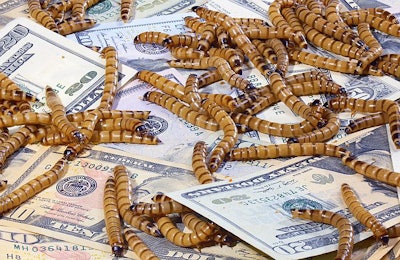
In 2018, insects ranked No. 1 among all pet food ingredients searched for on PetfoodIndustry.com – more than several other ingredients prevalent in the news, such as potatoes and taurine (related to the canine dilated cardiomyopathy issue) and CBD. Interest and focus on insect protein for pet food has only accelerated in 2019. Are we soon approaching the point when this is a viable protein option for pet food producers worldwide?
Insect-based pet food companies, suppliers growing in EU
European Union (EU) regulations have permitted the use of insect protein in pet food for a few years now. Initially, this encouraged the development of a dog food here or there using the ingredient – seemingly experiments or early adopter market tests by established pet food companies already offering traditional products and proteins.
Yet now we see companies in the EU offering insect-protein-based pet foods exclusively: Yora, based in the UK; Entoma, based in France and Denmark, to name a couple. (Watch for an article on Entoma in the June 2019 issue of Petfood Industry magazine.)
One reason these pet food companies have been able to specialize in such products is because the insect-protein supply chain has been steadily emerging and growing in Europe, often bolstered by funding of suppliers by third-party investors who apparently know a hot ticket when they see it. Consider:
- Food and agriculture investment group AgFunder reported that two insect-protein suppliers, Agriprotein (based in the UK and South Africa) and Ÿnsect (based in France) broke the record in 2018 for the largest amount of funding raised by insect farms.
- The insect industry overall (including for human food) reported investments of US$300 million* in 2018, according to a press release from Buhler Insect Technology Solutions (BITS) and Alfa Laval.
- The fact that a large, multinational conglomerate such as Buhler, known for its processing equipment, research and solutions, went full in on bugs to the extent of forming a partnership and building an industrial plant with insect protein supplier Protix in 2017 (BITS) helps prove the viability of this ingredient. Protix itself has received several rounds of funding the past several years.
Will new pet nutrition research help make insects’ case in US?
In the largest pet food market, the U.S., insect protein is not yet allowed in pet foods, at least not complete and balanced diets. Insect-based treats have been proliferating, but to date, the regulations and supply chain have not been there for full pet diets.
That, too, may soon be changing. I have heard anecdotally that a formal definition in the Official Publication of the Association of American Feed Control Officials (AAFCO) – a first and required step to gain regulatory approval – is being “fast-tracked,” at least for black soldier fly larvae (BSFL). I’m not sure just how fast that might mean for a typically slow-moving, deliberative body such as AAFCO, yet one development that could help is recent research showing the benefits that insect protein offers to pets.
For example, feeding trials of dogs and cats fed kibble made with BSFL protein or oil showed strong acceptance and digestibility of the pet foods compared to controls of kibble made with traditional proteins. The research was conducted by Ryan Yamka, Ph.D., of Luna Science and Nutrition in conjunction with Enviro Flight, a growing Ohio, USA-based company specializing in BSFL ingredients.
Similarly, researchers at Iowa State University, led by assistant professor Mariana Rossoni Serao, Ph.D., are conducting a multi-phase study on the use of cricket protein in dog food, in partnership with Jiminy’s, maker of a cricket-based dog treat, and AnimalBiome. (Note: Yamka and Rossoni Serao both presented their research at Petfood Forum 2019.)
Is the ‘yuck factor’ a deterrent in pet food?
Proponents of insect protein stress its sustainability, which over time will also help bring the cost down, along with the growth of the supply chain. That leading feature may also attract millennials, the largest pet-owning population now, who in general seem more likely to buy – even pay a premium for – more sustainable products.
Aside from the cost, supply chain and, at least in the U.S., regulatory challenges, the most notable argument often heard about insect protein is the “yuck factor.” Despite many cultures and people around the world considering insects a diet staple, that’s not at all the case in the West, a fact frequently cited as being a deterrent against acceptance of insect protein in human foods.
But I honestly don’t get that being an issue with pet food. As much as pet owners humanize their pets, most probably have seen their precious dog or cat readily chase and possibly devour all sorts of insects. Especially for owners who believe their pets should eat “as they would in the wild,” what could be more apropos than bugs?
*Note: The figure for reported investments in the overall insect protein industry (human food and pet food) has been corrected from U.S.$300 billion to U.S.$300 million. I apologize for the error.


















